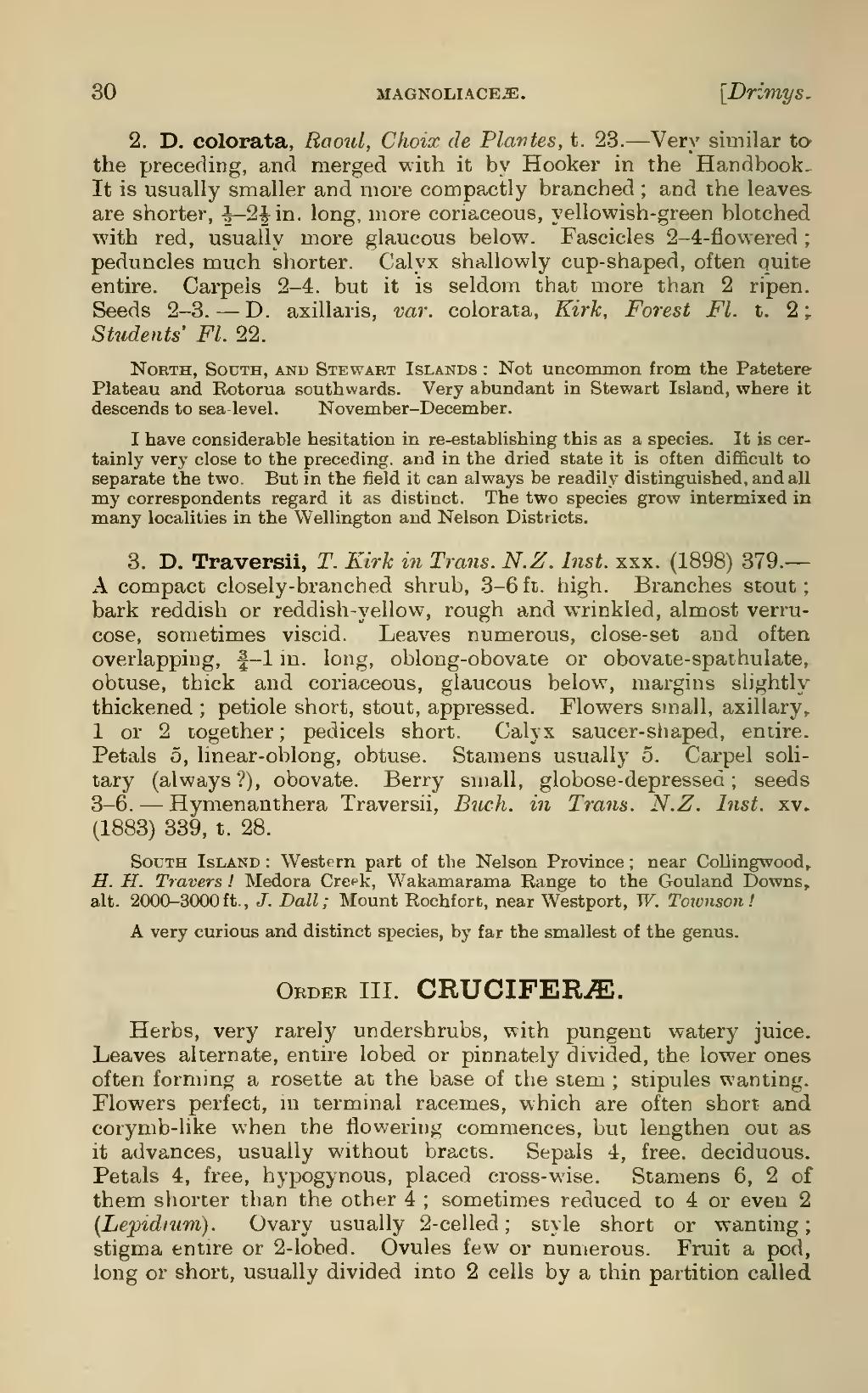2. D. colorata, Raoul, Choix de Plantes, t. 23.—Very similar to the preceding, and merged with it by Hooker in the Handbook. It is usually smaller and more compactly branched; and the leaves are shorter, ½–2½ in. long, more coriaceous, yellowish-green blotched with red, usually more glaucous below. Fascicles 2–4-flowered; peduncles much shorter. Calyx shallowly cup-shaped, often quite entire. Carpels 2–4, but it is seldom that more than 2 ripen. Seeds 2–3.—D. axillaris, var. colorata, Kirk, Forest Fl. t. 2; Students' Fl. 22.
North, South, and Stewart Islands: Not uncommon from the Patetere Plateau and Rotorua southwards. Very abundant in Stewart Ishmd, where it descends to sea-level. November–December.
I have considerable hesitation in re-establishing this as a species. It is certainly very close to the preceding, and in the dried state it is often difficult to separate the two. But in the field it can always be readily distinguished, and all my correspondents regard it as distinct. The two species grow intermixed in many localities in the Wellington and Nelson Districts.
3. D. Traversii, T. Kirk in Trans. N.Z. Inst. xxx. (1898) 379.—A compact closely-branched shrub, 3–6 ft. high. Branches stout; bark reddish or reddish-yellow, rough and wrinkled, almost verrucose, sometimes viscid. Leaves numerous, close-set and often overlapping, ¾–1 in. long, oblong-obovate or obovate-spathulate, obtuse, thick and coriaceous, glaucous below, margins slightly thickened; petiole short, stout, appressed. Flowers small, axillary, 1 or 2 together; pedicels short. Calyx saucer-sliaped, entire. Petals 5, linear-oblong, obtuse. Stamens usually 5. Carpel solitary (always?), obovate. Berry small, globose-depressed; seeds 3–6.—Hymenanthera Traversii, Buch. in Trans. N.Z. Inst. xv. (1883) 339, t. 28.
South Island: Western part of the Nelson Province; near Collingwood, H. H. Travers! Medora Creek, Wakamarama Range to the Gouland Downs, alt. 2000–3000 ft., J. Dall; Mount Rochfort, near Westport, W. Townson!
A very curious and distinct species, by far the smallest of the genus.
Order III. CRUCIFERÆ.
Herbs, very rarely undershrubs, with pungent watery juice. Leaves alternate, entire lobed or pinnately divided, the lower ones often forming a rosette at the base of the stem; stipules wanting. Flowers perfect, in terminal racemes, which are often short and corymb-like when the flowering commences, but lengthen out as it advances, usually without bracts. Sepals 4, free, deciduous. Petals 4, free, hypogynous, placed cross-wise. Stamens 6, 2 of them shorter than the other 4; sometimes reduced to 4 or even 2 (Lepidium). Ovary usually 2-celled; style short or wanting; stigma entire or 2-lobed. Ovules few or numerous. Fruit a pod, long or short, usually divided into 2 cells by a thin partition called
